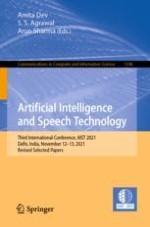This volume constitutes selected papers presented at the Third International Conference on Artificial Intelligence and Speech Technology, AIST 2021, held in Delhi, India, in November 2021.
The 36 full papers and 18 short papers presented were thoroughly reviewed and selected from the 178 submissions. They provide a discussion on application of Artificial Intelligence tools in speech analysis, representation and models, spoken language recognition and understanding, affective speech recognition, interpretation and synthesis, speech interface design and human factors engineering, speech emotion recognition technologies, audio-visual speech processing and several others.
